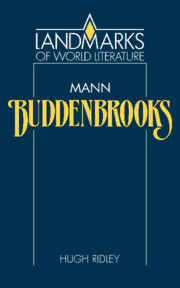Book contents
- Frontmatter
- Contents
- Acknowledgements
- Chronology
- Chronology of Buddenbrooks
- 1 Life and works
- 2 Retrospect on the nineteenth century
- 3 The evolution of the novel
- 4 The theme of decline
- 5 Stages in decline
- 6 Thomas Buddenbrook
- 7 Narrative technique
- 8 The Buddenbrooks' decline: a typical story?
- 9 Literary background and reading public
- 10 Buddenbrooks and the ‘crisis of the novel’
- Suggestions for further reading
7 - Narrative technique
Published online by Cambridge University Press: 15 December 2009
- Frontmatter
- Contents
- Acknowledgements
- Chronology
- Chronology of Buddenbrooks
- 1 Life and works
- 2 Retrospect on the nineteenth century
- 3 The evolution of the novel
- 4 The theme of decline
- 5 Stages in decline
- 6 Thomas Buddenbrook
- 7 Narrative technique
- 8 The Buddenbrooks' decline: a typical story?
- 9 Literary background and reading public
- 10 Buddenbrooks and the ‘crisis of the novel’
- Suggestions for further reading
Summary
We turn in this section to consider the fabric of the novel's text and to examine more closely the way in which its themes and concerns are embedded in the narrative. We must not expect to find the stages of the story's evolution preserved like fossil layers in the final text. It is questionable whether such fossil layers could be established, even if the manuscript had survived, but they would in any case add little to our reading of a text whose nature – clearly stamped by that intellectualising which represented the third stage of the text's evolution – is to work over and analyse everything which it communicates. Both the perspective of the ‘sensitive late-comer’ and that of the ‘municipal chronicle’ are preserved, but both are orchestrated into a multiplicity of perspectives, which are played off against each other and relativised in their claims to truth. The only perennial feature of Mann's narrative stance is that it is always changing, and that no position is accepted as providing the exclusive perspective of the novel.
Point of view
A clear example of this shifting perspective can be found in the opening section of Part Seven, which deals with Hanno's christening, or rather – for that is the perspective with which the chapter opens – with what turns out to be Tony's christening. The first sentence sets the excitement of the event: ‘Christening! … A christening in Broad Street!’ What we are then shown is everything ‘that Madame Permaneder had, in hopeful days, dreamt of beholding’.
- Type
- Chapter
- Information
- Mann: Buddenbrooks , pp. 69 - 85Publisher: Cambridge University PressPrint publication year: 1987

